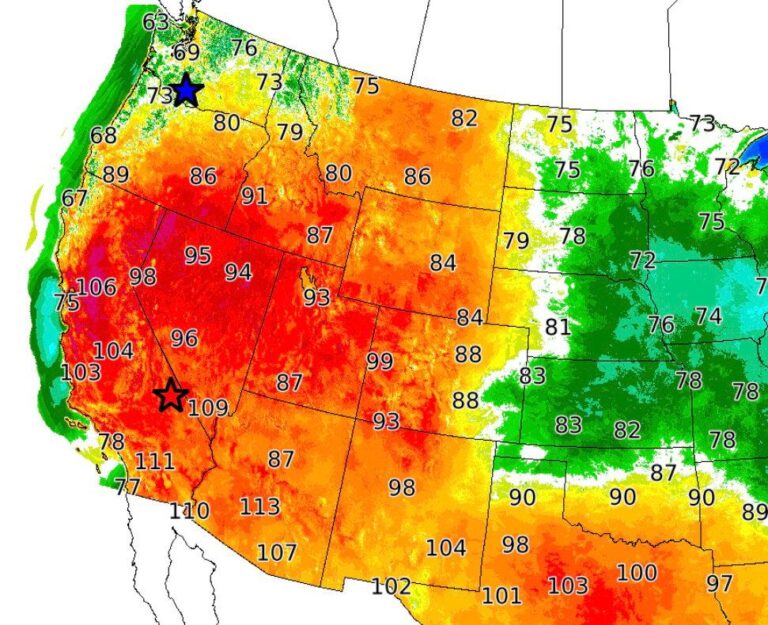A dangerous heat wave has struck parts of the Southwest U.S., bringing record-breaking temperatures and raising serious concerns for public health and safety. As communities grapple with extreme heat warnings, officials are urging residents to take precautions to stay cool and hydrated amid soaring temperatures that threaten to strain power grids and increase the risk of heat-related illnesses. This developing situation has prompted emergency responses and heightened awareness across the region as the effects of the intense heat wave continue to unfold.
Dangerous Heat Wave Sweeps Across Southwest United States
The Southwest United States is currently grappling with record-breaking temperatures as a severe heat wave extends across multiple states. Meteorologists report that daytime highs in cities like Phoenix, Las Vegas, and Albuquerque have surpassed historical averages by almost 15 degrees Fahrenheit. This extreme heat has led to increased heat advisories, straining local infrastructure, and causing widespread disruptions to daily life and outdoor activities.
Officials urge residents to take immediate precautions to safeguard their health and property. Key recommendations include:
- Stay hydrated by drinking plenty of water throughout the day.
- Avoid strenuous outdoor activities, especially during peak afternoon hours.
- Check on vulnerable neighbors, such as the elderly and young children.
- Utilize cooling centers available in urban areas to escape the heat.
- Be mindful of pets and livestock, ensuring they have adequate shade and water.
| City | Current Temp (°F) | Heat Advisory Status |
|---|---|---|
| Phoenix, AZ | 115 | Extreme |
| Las Vegas, NV | 112 | High |
| Albuquerque, NM | 108 | Moderate |
Health Risks and Safety Precautions Amid Rising Temperatures
As the Southwest grapples with unprecedented heat levels, public health officials warn of serious risks including heat exhaustion, heatstroke, and dehydration. Vulnerable groups such as the elderly, young children, and those with chronic illnesses face heightened dangers. To combat these threats, it is crucial to stay hydrated, avoid prolonged outdoor activities during peak sun hours, and seek air-conditioned environments whenever possible. Symptoms warranting immediate medical attention include dizziness, rapid heartbeat, confusion, and loss of consciousness.
Key safety measures to reduce heat-related health risks include:
- Consuming plenty of water throughout the day
- Wearing lightweight, loose-fitting clothing
- Using sunscreen to minimize sunburn
- Taking frequent breaks in shaded or cool areas
- Never leaving children or pets unattended in vehicles
| Symptom | Recommended Action |
|---|---|
| Excessive sweating & weakness | Rest in a cool place; hydrate immediately |
| High body temperature & confusion | Seek emergency medical help |
| Rapid heartbeat & dizziness | Lie down and elevate feet; cool compress |
Impact on Infrastructure and Power Supply Challenges
The unprecedented heat wave sweeping across the Southwest U.S. has placed immense strain on regional infrastructure, pushing power grids to their limits. Utility companies report surges in electricity demand as residents and businesses crank up air conditioning to unbearable highs, risking widespread outages. Critical transportation arteries buckle under extreme temperatures, with asphalt melting and rail lines experiencing dangerous warping, leading to potential disruptions in freight and commuter travel.
Key infrastructure challenges include:
- Accelerated wear on electrical transformers and substations
- Increased risk of blackouts during peak usage hours
- Damage to road surfaces and rail tracks requiring emergency repairs
- Strained water supply systems struggling to meet irrigation and cooling demands
| Infrastructure Element | Impact | Mitigation Efforts |
|---|---|---|
| Power Grid | Overload, transformer failures | Rolling blackouts, demand response programs |
| Roadways | Surface melting, cracks | Temperature-resistant materials, rapid repairs |
| Rail Systems | Track warping, delays | Speed restrictions, track monitoring |
| Water Supply | Increased consumption, reservoir depletion | Water restrictions, emergency deliveries |
Cooling Centers and Community Support Resources Available
In response to the escalating heat emergency across the Southwest, local authorities have mobilized numerous cooling centers offering refuge to those impacted by the soaring temperatures. These centers are equipped with air conditioning, water stations, and seating areas to ensure community members can find relief safely. Most facilities operate during peak heat hours, typically from 10 a.m. to 8 p.m., providing extended access to vulnerable populations such as the elderly, children, and individuals with underlying health conditions.
Community support doesn’t stop at cooling centers. Various organizations have launched outreach initiatives including hydration stations, emergency transportation, and wellness check-ins to reduce heat-related risks. Emergency shelters are also ready to assist residents without adequate home cooling or those displaced by heat-induced power outages. Below is a list of prime locations and essential services available during this critical period:
- City Library Cooling Center – Open daily, 10 a.m. to 8 p.m.
- Community Recreation Center – Extended hours for seniors and families
- Mobile Hydration Units – Roaming neighborhoods during peak heat
- 24/7 Emergency Shelter – For residents experiencing outages or homelessness
| Facility | Address | Hours | Contact |
|---|---|---|---|
| Sunset Public Library | 123 Elm Street | 10 a.m. – 8 p.m. | (555) 123-4567 |
| Westside Community Center | 456 Pine Avenue | 9 a.m. – 9 p.m. | (555) 234-5678 |
| Downtown Emergency Shelter | 789 Maple Blvd | Open 24/7 | (555) 345-6789 |
Future Outlook
As the Southwest continues to grapple with this unprecedented heat wave, residents are urged to take necessary precautions to stay safe and hydrated. Authorities remain vigilant, monitoring conditions and providing updates as temperatures are expected to remain dangerously high in the coming days. CBS News will continue to follow the story and bring the latest developments on this severe weather event.







